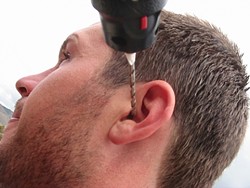[{
"name": "Ad - Medium Rectangle CC01 - 300x250",
"id": "AdMediumRectangleCC01300x250",
"class": "inlineCenter",
"insertPoint": "8",
"component": "2963441",
"requiredCountToDisplay": "12"
},{
"name": "Ad - Medium Rectangle LC01 - 300x250",
"id": "AdMediumRectangleCC01300x250",
"class": "inlineCenter",
"insertPoint": "18",
"component": "2963441",
"requiredCountToDisplay": "22"
},{
"name": "Ad - Medium Rectangle LC09 - 300x250",
"id": "AdMediumRectangleLC09300x250",
"class": "inlineCenter",
"insertPoint": "28",
"component": "3252660",
"requiredCountToDisplay": "32"
}]
The local surf was strong a week or two ago, and the winds were even stronger. Combine those rugged environmental elements with water temperatures hovering in the severe-shrinkage section of the thermometer and many ocean sport addicts were exposed to a potentially deafening condition: surfer's ear.
# Though surfer's ear or exostoses of the ear canal, as the medical community refers to it takes years of repeated cold-water penetration to mature into a genuine problem, early symptoms can be painful and preventable.
Exostoses of the ear canal is a condition where excessive bony growth in the outer ear canal forms in an attempt to block unwanted water from entering. The narrowing can trap water in the canal, often resulting in agonizing ear infections and partial hearing loss. It's the body's defense mechanism.
To help visualize the effects of this condition, imagine a straw that slowly builds up residue on the sides of its walls. As the amount of residue increases, the straw's diameter shrinks. Now imagine that it's happening to your ear.
The frigid conditions on the Central Coast coastline are ideal for developing this kind of physical disorder, according to physicians.
Dr. Lisa Molin a San Luis Obispo-based ear, throat, and nose specialist has helped local surfers combat this auditory problem for the past seven years. She estimates that she sees five people per week with varied levels of exostoses of the ear canal, and, of those, she operates on two per month.
The goal of the surgery is to remove the abnormal bone growth to make a new, conventionally shaped ear canal. Molin says she performs two procedures to rid the ear canal of excessive bone growth, both involving a drill inserted into the patient's ear.
During the first method, she makes an incision behind the ear, pulls the partially detached ear forward toward the face to expose the ear canal, and drills away the excess growth. For the other technique, Molin's preferred approach, she drills directly through the ear canal. Both operations are done with a micro chisel and can cost several thousand dollars per ear. But according to Molin, the procedure is often covered by most health insurance plans.
Mike Hischier is one local wave rider and owner of Wavelengths Surf Shop in Morro Bay who's received the operation. Even though he was experiencing hearing complications and was becoming more susceptible to ear infections, he wasn't stoked on the idea on having a drill in his head. It wasn't until his wife caught him trying to read people's lips that he went to a doctor for a professional diagnosis.
"That was the straw that broke the donkey's back," said Hischier, who learned that his right ear was virtually 100 percent closed after the analysis.
He spent four hours on an operating table to remove the bone build-up. Now, after the operation, Hischier wears earplugs and a hood all the time in the water, even on warm, wind-free days.
"The water is so cold and the wind is so aggravating here, I wear them religiously," he said.
For hard-of-hearing surfers considering the operation, Molin suggests making sure to time the surgery appropriately to avoid the temptation of returning to the water too soon. The recuperation process typically sidelines surfers for three to eight weeks. Though the surgery has obvious risks, Molin said many of her patients consider the time out of the water to be the most serious complication.
The majority of patients Molin treats regarding the problem are men between 20 and 50 years old. But surfer's ear can build up in any gender at any age and is directly related to the amount of time spent in cold water without proper protection. Molin said that young people have the highest risk of obtaining surfer's ear because they're exposed to the cold conditions when their skull is still developing.
Scott Robertson, M.D., medical director of Ventana Health and Medical Center in Pismo Beach, recommends a post-surf-session home remedy mixture made of two parts white vinegar with one part rubbing alcohol. He suggests two droplets of the concoction in each ear after exiting the water. The vinegar helps battle bacteria build-up while the alcohol helps to dry any lingering water.
And if that doesn't completely rid the residing water, he urges people to fight the temptation of inserting objects in their ear for relief.
"Under no circumstance should anyone put anything in their ear, including Q-tips," Robertson said.
Everyone interviewed agreed that the best way to minimize the potential damage caused by surfer's ear is to practice safe surfing and always use protection. In their experiences and studies, neoprene hoods were helpful and provided a decent defense but sometimes became more of a hindrance than help and actually trapped in water. Earplugs provided the highest rate of protection.
"I know what they can protect," Hischier said. "I even wear earplugs in the shower."
Staff Writer Kai Beech can be reached at [email protected].
Latest in News
Readers also liked…
-

Coast Unified teachers upset over new position's salary and qualifications
Oct 20, 2022 -

SLO police identify alleged driver who hit and killed couple
Dec 22, 2022 -

When the levee breaks: Oceano residents, county officials walk a tightrope of regulations to manage Arroyo Grande Creek, which some say led to the levee's failure in January
May 18, 2023







